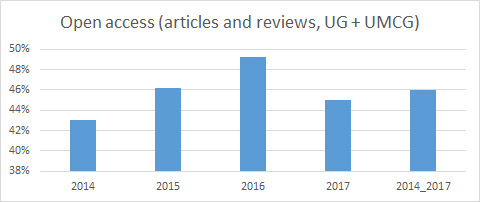Open access in numbers
100% open access in 2020 for publicly funded research is the ambition of the Netherlands. With only two years to go, it is time for some number crunching. How far are we on the way to openness? How many of our research articles are published open access? Which open access numbers are available and what are they based on?
The ambition of the Dutch government is to achieve 100% open access for publicly funded research in 2020 as described in the National Plan for Open Science . Universities, publishers, libraries and researchers have been confronted with this open access ambition; negotiations on a national level have resulted in publisher deals. In the UG and UMCG, numerous campaigns, newsletters, seminars and workshops introduced the concepts and opportunities of open access as well as funding options. With two years to go, we think it is time to let the numbers speak.
Monitoring by universities
All universities in the Netherlands are required to monitor their research output, including open access numbers for peer-reviewed articles. Of all peer-reviewed articles published in 2016 by Dutch universities, 42% were open access, according to the Roadmap to open access 2018-2020 by the VSNU, the association of universities in the Netherlands. This number is based on data from the individual universities, collected by the VSNU on a yearly basis. For the UG and UMCG, the data are based on the registration of research publications in the institutional research database PURE. Since universities are still working on registration and validation, it is too early to compare the numbers in detail among all Dutch universities. It is also difficult to compare the open access output with the years before, because data before 2016 are even less precise.
Analysis of Web of Science data
Since December 2017, the multidisciplinary database Web of Science (WoS) provides information about the open access status of articles. Research output retrieved by WoS can be filtered by four open access components: all open access, gold open access (both gold and hybrid journals), green published and green accepted articles. If all journal articles and reviews from the UG and the UMCG are searched in Web of Science and analyzed for open access status, we find 46% open access over the years 2014 to 2017 (see figure).

The graph shows that the relative number of open access publications steadily increases from 43% in 2014 to almost 50% in 2016. For 2017, the number is much lower due to the fact that open access data for 2017 is not yet complete. For example, there may be delays because of embargo periods by publishers, registration delays in repositories, and the uptake of information by Web of Science.
More than 85% of open access articles in 2014-2017 were gold open access (gold open access as well as hybrid publications). However, less than 15% were green open access. An example of green open access is the final author’s version of an article that is made available in the UG and UMCG’s research database PURE.

